Large gains in decentralized finance (DeFi) tokens in 2020 have turned heads and provoked interest and speculation. Sector experts have taken this as an endorsement of the emerging use cases and rapid innovations possible within the space, but external observers are taking a more skeptical view. Set against global economic stagnation and political instability, the rapid price rise in DeFi is being derided as a bubble, alongside inevitable comparisons to the initial coin offering (ICO) boom and bust of 2017 and 2018. While this view is understandable, it fails to take into consideration the unique characteristics of the technologies and use cases driving current interest, and how they materially differ from the hype of the last boom.
Let’s start by considering the similarities. Digital assets that have been built by a community of highly technical experts are rapidly increasing in value, coupled with high volatility in prices. Established companies facing commercial difficulty are making rhetorical “pivots” to this new technology in order to establish a brand that attracts a new caliber of investor. Last time around we saw Long Island Iced Tea Company rebrand as Long Blockchain Corp. with disastrous results, and there are rumblings of similar rebrands disguised as pivots into the DeFi space. A lack of regulatory oversight creates the potential for scams, with charismatic founders or slick marketing leading inexperienced investors to put money into projects that are not fundamentally sustainable.

But dig a little deeper and the differences between the two booms are far more apparent than the similarities. While prices have varied significantly, much of the volatility can be traced back to a lack of liquidity based on a constrained supply rather than speculation or pumping and dumping. This is certainly a pain and does not help with DeFi’s brand, but it is a technical challenge that can be addressed through education and the provision of liquidity pools. Most companies pivoting into DeFi are coming with a background in technology; for example, Tron’s move into DeFi draws from the company’s experience as an operating system, and its TRX coin is now being used by 20 DeFi projects. And while lack of regulation is a concern, leaders within the community are calling for industry standards and regulatory sandboxes, with some pointing to February’s safe harbor proposal by SEC Commissioner Hestor Peirce as a positive step towards addressing the issue.
DeFi’s rise and ICO boom are functionally different
This final point on the meritocracy of DeFi as a technology and a foundation for innovation is the most important one, and one that sets it apart from the ICO boom. There is a clear functionality built into DeFi that can be examined and critiqued, something that was not true of some ICOs that took place in an environment that at times felt more like a free-for-all than a marketplace. DeFi technology gives borrowers and lenders full control over setting their own rates and requirements while removing the costs associated with third party intermediaries. It allows for smart contracts that will disrupt swaths of the legal and compliance industry. By using synthetics, these can even be conducted across multiple blockchains.
One indicator that the current DeFi market is different to the ICO boom of the past is that the value of DeFi assets do not correlate with bitcoin prices, unlike many coins. This implies that its assets derive value from the standalone functionality of the DeFi technology rather than speculation or hedges against economic or fiscal concerns. It is the intrinsic potential for use cases and functionality within DeFi that drives its value, rather than external factors.
While the principles of DeFi are robust, none of the predictions for the technology are set in stone. Like in traditional financial markets, the greatest threat to the DeFi asset space is that long-term value investors could become influenced by short-term trades. DeFi will continue to be successful to the extent that it can enable and attract the former, while accommodating the latter.
Getting to equilibrium
One of the best ways to improve longevity in the DeFi market is to promote greater ownership among non-technical, retail investors. Doing so requires that they are able to access, and benefit from, DeFi services, which means the services must be built with non-technical users in mind. Infrastructure providers have a duty here to do the non-glamorous work of building improved tooling that uses analytics and a focus on user experience to unlock DeFi’s full potential for a non-technical user base. Sustainability of DeFi requires that non-technical investors are attracted by the application of technology in the first instance, rather than being driven by speculation or the opportunity to make money trading tokens.
A healthy DeFi ecosystem requires casual, retail investors as well as experts. Sustained value in the space will come from systemic trust and, while this may cause some crypto idealists to recoil, this means that further institutional involvement is necessary to sustain DeFi, at least in the medium-term. Institutional investors bring brands that stretch back decades and even centuries into the space. Retail investors are more likely to trust players operating in the space that have reputational skin in the game, rather than entrepreneurs who may have a better grasp of the technology and the market but are unknown in the eyes of the public.
As with all predictions, we have to talk about probabilities rather than binary outcomes. Because DeFi is inherently decentralized, the sustainability of the boom is partially in the hands of the community. Leaders in the space need to keep making the case for sensible standards and self-regulation, at a minimum. If participants take a zero-sum approach that maximizes short-term interests, then a bubble becomes a self-fulfilling prophecy. But if they consider the structure of the network as a factor in their decisions, foster systemic trust and seek long-term value, the functionality and innovation of DeFi can create far more value for all involved. As someone who has worked with the technology and the community for years, I have faith that we will do the right thing.




